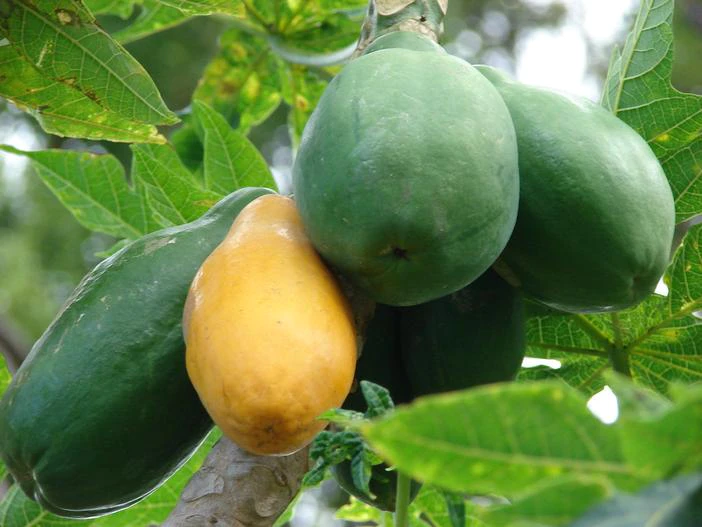Papaya
(Carica papaya)
Papaya (Carica papaya)
/
/

Forest and Kim Starr
CC BY 2.0
Image By:
Forest and Kim Starr
Recorded By:
Copyright:
CC BY 2.0
Copyright Notice:
Photo by: Forest and Kim Starr | License Type: CC BY 2.0 | License URL: https://creativecommons.org/licenses/by/2.0/ | Uploader: Starr Environmental | Publisher: Flickr












































































Estimated Native Range
Climate Requirements for Haltom City, Texas
| This Plant | Your Site | Plant Suitability for Your Location | ||
|---|---|---|---|---|
| • Precipitation | 0" - 260" | 34" | Your precipitation may be insufficient for this plant. Irrigate N" / year. | Irrigate N" / year |
| • High Temp. | 58°F - 110°F | 97°F | Your summer temperatures are normal for this plant. | Excellent |
| • Low Temp. | -10°F - 91°F | 33°F | Your winter temperatures are normal for this plant | Excellent |
This plant should grow well at your location with about N inches per year (Y minutes per month) of irrigation.
Summary
Carica papaya, commonly known as Papaya, is an evergreen tree or large shrub native to tropical rainforests of Central America and the northern regions of South America. It typically grows from 5 to 10 meters (16 to 33 feet) tall with a single trunk. The leaves are large, palmate, and spirally arranged at the top of the trunk, with the lower trunk marked by scars from previous leaves and fruits. Papaya trees feature highly dimorphic flowers; male flowers have stamens fused to the petals, while female flowers have a superior ovary and five contorted petals. Both male and female flowers are borne in the leaf axils, with the male flowers in multiflowered dichasia and the female in few-flowered dichasia. The flowers are sweet-scented, open at night, and pollinated by wind or insects. The fruit is a large berry, 15–45 cm (5.9–17.7 in) long and 10–30 cm (3.9–11.8 in) in diameter, with a central cavity filled with black seeds. When ripe, the fruit softens, its skin turns amber to orange, and it is typically consumed raw.
The Papaya is valued for its edible fruit, which is high in vitamins and enzymes like papain. It is often grown in tropical and subtropical regions for its fruit and as an ornamental plant. Papayas require full sun, ample water, and well-drained soil to thrive. They are not tolerant of frost and must be protected from cold temperatures. In cultivation, they are often grown in containers or greenhouses in cooler climates. While papayas are relatively easy to grow, they can suffer from pests like fruit flies and diseases such as papaya ringspot virus. It is also potentially invasive in some regions, so gardeners should be aware of local regulations before planting.CC BY-SA 4.0
The Papaya is valued for its edible fruit, which is high in vitamins and enzymes like papain. It is often grown in tropical and subtropical regions for its fruit and as an ornamental plant. Papayas require full sun, ample water, and well-drained soil to thrive. They are not tolerant of frost and must be protected from cold temperatures. In cultivation, they are often grown in containers or greenhouses in cooler climates. While papayas are relatively easy to grow, they can suffer from pests like fruit flies and diseases such as papaya ringspot virus. It is also potentially invasive in some regions, so gardeners should be aware of local regulations before planting.CC BY-SA 4.0
Plant Description
- Plant Type: Tree
- Height: 6-20 feet
- Width: 3-15 feet
- Growth Rate: Rapid
- Flower Color: N/A
- Flowering Season: Spring, Winter
- Leaf Retention: Evergreen
Growth Requirements
- Sun: Full Sun
- Water: High
- Drainage: Medium, Fast
Common Uses
Bee Garden, Edible*Disclaimer: Easyscape's listed plant edibility is for informational use. Always verify the safety and proper identification of any plant before consumption., Fragrant, Potted Plant
Natural Habitat
Native to tropical rainforests of Central America and the northern regions of South America
Other Names
Common Names: Papaw , Pawpaw , Melonenbaum , Papajabaum , Papajapflanze , Mamón , Papayero , Papayer , Mamão , Papaja
Scientific Names: Carica papaya , Carica peltata , Papaya carica , Papaya papaya , Carica papaya var. bady , Carica jamaicensis , Papaya vulgaris , Carica cubensis , Carica papaya f. portoricensis , Carica pinnatifida
GBIF Accepted Name: Carica papaya L.